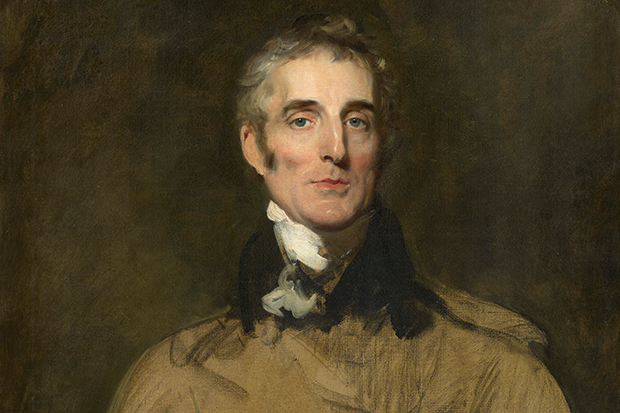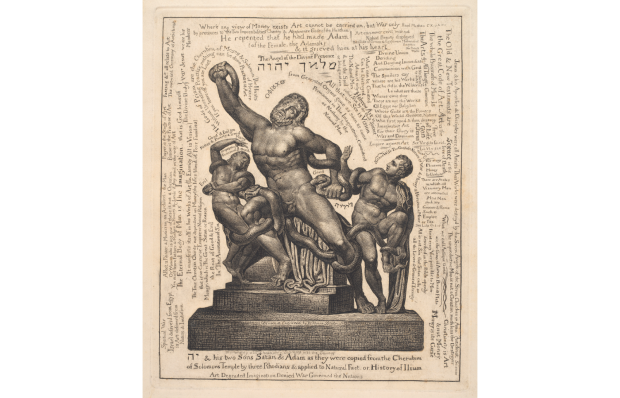The history of portraiture is festooned with images of sitters overwhelmed by dress, setting and the accoutrements of worldly success. Vanity, complacency and, frequently, insecurity have led men and women to commission or sit for likenesses in which an extra swag of braid, another row of pearls, flounce of silk or plume topples the finished image from celebration to indictment. In such portraits, the artist hardly needs to essay psychological insights: luscious visual bombast betrays the chasm between appearance and truth. In images as diverse as Van Eyck’s ‘Arnolfini Portrait’ of 1434, Antoine-François Callet’s 1775 coronation portrait of Louis XVI and Sargent’s ‘Mrs Carl Meyer and her Children’ of 1896, ostentation becomes the keynote that, unwittingly on the sitters’ part, leads to revelations.
There is a challenge here for the artist whose regard for his distinguished, high-ranking subject is sincere or, as in the case of artists tasked with painting the 1st Duke of Wellington, the focus of an exhibition at the National Portrait Gallery, whose subject inspired widespread admiration. The current exhibition commemorates the bicentenary of Wellington’s victory over Napoleonic forces at Waterloo. In portraits by Francisco de Goya and Thomas Lawrence, it shows artists evolving an iconography of heroism appropriate to Wellington’s status as conqueror: the military commander (and subsequently, on two occasions, prime minister) posthumously acclaimed by Tennyson as ‘the last great Englishman’.
It is Lawrence who wins the laurels for investing Wellington’s portraiture with that aura of unassailability that persuaded not only the Duke’s contemporaries, but also subsequent generations. Lawrence’s earliest portrait was begun even before Waterloo, in the summer of 1814. Lawrence’s swaggering full-length depicts Wellington in the uniform of a Field Marshal, brandishing the Sword of State and framed by a triumphal arch. Behind him an apocalyptic sky smoulders; Wellington himself steps out of chaos into the order of victory. In this, his first attempt, the Duke’s face is as it will remain in Lawrence’s portraits: hook-nosed, with high cheekbones, a tight, resolute mouth, a suspicion of shadowy stubble and a mix of humour and aloofness in the clear, unblinking eyes. The portrait was commissioned by the Prince Regent: today it remains in Windsor Castle’s Waterloo Chamber. It is simultaneously a likeness and a vision of national bravado.
Lawrence revisited this iconography of ramrod-backed hauteur on at least three occasions, most famously in the portrait of 1817–18 that, from 1971, featured on £5 notes. In 1821, he depicted a greying Duke in a capacious greatcoat: the steely challenge of dark eyes and compressed lips is undimmed. Eight years later, at the request of Lady Jersey, Lawrence embarked on his final image of Wellington, which was unfinished at the artist’s death in 1830. On loan to the National Gallery from an American private collection, this little-known work successfully blends heroic arrogance with the weariness of an ageing Regency buck.
That human note is key to Goya’s portrait, begun in 1812 and repeatedly revised until 1814 to incorporate Wellington’s growing collection of decorations. Goya’s Wellington is encased in a uniform weighted with honours. But the man himself has yet to achieve apotheosis. His parted lips suggest traces of uncertainty.
In time, uncertainty vanished from Wellington’s portraiture — instead successive artists focused on depicting a man of force and destiny. In John Simpson’s portrait in the Royal Hospital Chelsea, which is not included in the current exhibition, Wellington has become a bland cipher of the successful militarist. This shift from accurate representation to conceptualisation is indicative of Wellington’s emblematic status. It reveals the truth of the public figure while effectively masking the private man.
Got something to add? Join the discussion and comment below.
Get 10 issues for just $10
Subscribe to The Spectator Australia today for the next 10 magazine issues, plus full online access, for just $10.
You might disagree with half of it, but you’ll enjoy reading all of it. Try your first month for free, then just $2 a week for the remainder of your first year.














Comments
Don't miss out
Join the conversation with other Spectator Australia readers. Subscribe to leave a comment.
SUBSCRIBEAlready a subscriber? Log in